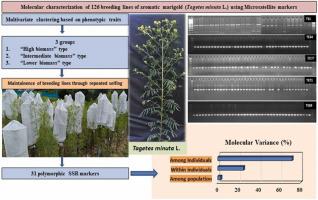Journal of Applied Research on Medicinal and Aromatic Plants ( IF 3.9 ) Pub Date : 2023-09-09 , DOI: 10.1016/j.jarmap.2023.100514 Ajay Kumar , Hari Sharan , Diksha Dhiman , Rahul Dev Gautam , Ramesh Chauhan , Ashok Kumar , Satbeer Singh , Sanatsujat Singh

|
Aromatic marigold (Tagetes minuta L.) is an essential oil-bearing plant of industrial value. The essential oil obtained from the plant has high demand in the flavor and perfume industry. The present study investigates the molecular diversity patterns using microsatellite markers in 126 breeding lines representing three groups (higher, intermediate, and lower biomass) based on phenotypic characterization. These lines are being maintained through repeated selfing. A total of 503 alleles with an average of 16.23 alleles per locus were detected at 31 SSR loci over all the genotypes. The average most common and rare alleles were 3.35 and 12.87, respectively, over all the studied loci. The high polymorphic information content (0.88) and genetic diversity (0.89) indicate high allelic diversity among the genotypes studied. Ten genotype-specific markers were identified. Significant molecular variances have been observed among the groups (3 %), among individuals (72 %), and within individuals (26 %). The unweighted neighbor-joining clustering based on a simple matching dissimilarity index grouped all 126 genotypes into five major clusters. The clustering pattern primarily follows the biomass-specific distribution of populations. The principle coordinate analysis depicts considerable variations and again confirms the biomass-specific grouping of genotypes. The highly significant positive association between genotypic and phenotypic distances indicates the importance of these marker loci for future marker-assisted selection and association mapping studies.
中文翻译:

基于微卫星标记的芳香万寿菊(Tagetes minuta L.)育种系间的分子分化
芳香万寿菊(Tagetes minuta L.)是一种具有工业价值的精油植物。从该植物中提取的精油在香精香料行业有很高的需求。本研究基于表型特征,利用微卫星标记研究了代表三组(较高、中等和较低生物量)的126 个育种品系的分子多样性模式。这些品系通过反复自交得以维持。在所有基因型的31 个 SSR 位点上总共检测到 503 个等位基因,平均每个位点有 16.23 个等位基因。在所有研究基因座中,平均最常见和罕见等位基因分别为 3.35 和 12.87。高多态性信息含量 (0.88) 和遗传多样性 (0.89) 表明所研究的基因型之间具有高等位基因多样性。鉴定出十个基因型特异性标记。在群体之间(3%)、个体之间(72%)和个体内部(26%)观察到显着的分子差异。基于简单匹配相异指数的未加权邻接聚类将所有 126 个基因型分为 5 个主要聚类。聚类模式主要遵循种群的生物量特定分布。主坐标分析描绘了相当大的变化,并再次证实了基因型的生物量特异性分组。基因型和表型距离之间高度显着的正相关表明这些标记位点对于未来标记辅助选择和关联作图研究的重要性。



























 京公网安备 11010802027423号
京公网安备 11010802027423号